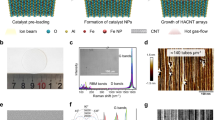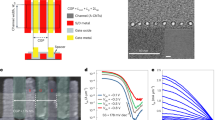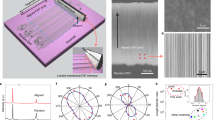Abstract
Single-walled carbon nanotubes have exceptional electronic properties and have been proposed as a replacement for silicon in applications such as low-cost thin-film transistors and high-performance logic devices1. However, practical devices will require dense, aligned arrays of electronically pure nanotubes to optimize performance, maximize device packing density and provide sufficient drive current (or power output) for each transistor2. Here, we show that aligned arrays of semiconducting carbon nanotubes can be assembled using the Langmuir–Schaefer method. The arrays have a semiconducting nanotube purity of 99% and can fully cover a surface with a nanotube density of more than 500 tubes/µm. The nanotube pitch is self-limited by the diameter of the nanotube plus the van der Waals separation, and the intrinsic mobility of the nanotubes is preserved after array assembly. Transistors fabricated using this approach exhibit significant device performance characteristics with a drive current density of more than 120 µA µm−1, transconductance greater than 40 µS µm−1 and on/off ratios of ∼1 × 103.
This is a preview of subscription content, access via your institution
Access options
Subscribe to this journal
Receive 12 print issues and online access
We are sorry, but there is no personal subscription option available for your country.
Buy this article
- Purchase on SpringerLink
- Instant access to full article PDF
Prices may be subject to local taxes which are calculated during checkout




Similar content being viewed by others
References
Appenzeller, J. Carbon nanotubes for high-performance electronics—progress and prospect. Proc. IEEE 96, 201–211 (2008).
Pimparkar, N., Kocabas, C., Kang, S. J., Rogers, J. & Alam, M. A. Limits of performance gain of aligned CNT over randomized network: theoretical predictions and experimental validation. IEEE Electron. Dev. Lett. 28, 593–595 (2007).
Kang, S. J. et al. High-performance electronics using dense, perfectly aligned arrays of single-walled carbon nanotubes. Nature Nanotech. 2, 230–236 (2007).
Hersam, M. C. Progress towards monodisperse single-walled carbon nanotubes. Nature Nanotech. 3, 387–394 (2008).
Sarker, B. K., Shekhar, S. & Khondaker, S. I. Semiconducting enriched carbon nanotube aligned arrays of tunable density and their electrical transport properties. ACS Nano 5, 6297–6305 (2011).
Engel, M. et al. Thin film nanotube transistors based on self-assembled, aligned, semiconducting carbon nanotube arrays. ACS Nano 2, 2445–2452 (2008).
LeMieux, M. C. et al. Self-sorted, aligned nanotube networks for thin-film transistors. Science 321, 101–104 (2008).
Hong, S. W., Banks, T. & Rogers, J. A. Improved density in aligned arrays of single-walled carbon nanotubes by sequential chemical vapor deposition on quartz. Adv. Mater. 22, 1826–1830 (2010).
Li, X. et al. Langmuir–Blodgett assembly of densely aligned single-walled carbon nanotubes from bulk materials. J. Am. Chem. Soc. 129, 4890–4891 (2007).
Tao, A. R., Huang, J. & Yang, P. Langmuir–Blodgettry of nanocrystals and nanowires. Acc. Chem. Res. 41, 1662–1673 (2008).
Petty, M. C. in Langmuir-Blodgett Films: An Introduction Ch. 2, 39–93 (Cambridge Univ. Press, 1996).
Cao, Q. et al. Medium-scale carbon nanotube thin-film integrated circuits on flexible plastic substrates. Nature 454, 495–500 (2008).
Sun, D. M. et al. Flexible high-performance carbon nanotube integrated circuits. Nature Nanotech. 6, 156–161 (2011).
Wang, C. et al. Extremely bendable, high-performance integrated circuits using semiconducting carbon nanotube networks for digital, analog, and radio-frequency applications. Nano Lett. 12, 1527–1533 (2012).
Miyata, Y. et al. Length-sorted semiconducting carbon nanotubes for high-mobility thin film transistors. Nano Res. 4, 963–970 (2011).
Sangwan, V. K. et al. Fundamental performance limits of carbon nanotube thin-film transistors achieved using hybrid molecular dielectrics. ACS Nano 6, 7480–7488 (2012).
Cao, Q. et al. Gate capacitance coupling of singled-walled carbon nanotube thin-film transistors. Appl. Phys. Lett. 90, 023516 (2007).
Kocabas, C. et al. Experimental and theoretical studies of transport through large scale, partially aligned arrays of single-walled carbon nanotubes in thin film type transistors. Nano Lett. 7, 1195–1202 (2007).
Rouhi, N., Jain, D., Zand, K. & Burke, P. J. Fundamental limits on the mobility of nanotube-based semiconducting inks. Adv. Mater. 23, 94–99 (2011).
Franklin, A. D. & Chen, Z. H. Length scaling of carbon nanotube transistors. Nature Nanotech. 5, 858–862 (2010).
Deng, J. & Wong, H. S. P. Modeling and analysis of planar-gate electrostatic capacitance of 1-D FET with multiple cylindrical conducting channels. IEEE Trans. Electron. Dev. 54, 2377–2385 (2007).
Leonard, F. Crosstalk between nanotube devices: contact and channel effects. Nanotechnology 17, 2381–2385 (2006).
Franklin, A. D., Wong, H. S. P., Lin, A. & Chen, Z. H. Current scaling in aligned carbon nanotube array transistors with local bottom gating. IEEE Electron. Dev. Lett. 31, 644–646 (2010).
Ho, X. N. et al. Scaling properties in transistors that use aligned arrays of single-walled carbon nanotubes. Nano Lett. 10, 499–503 (2010).
Cao, Q., Han, S. J., Tulevski, G. S., Franklin, A. D. & Haensch, W. Evaluation of field-effect mobility and contact resistance of transistors that use solution-processed single-walled carbon nanotubes. ACS Nano 6, 6471–6477 (2012).
Leonard, F. & Talin, A. A. Electrical contacts to one- and two-dimensional nanomaterials. Nature Nanotech. 6, 773–783 (2011).
Kocabas, C. et al. High-frequency performance of submicrometer transistors that use aligned arrays of single-walled carbon nanotubes. Nano Lett. 9, 1937–1943 (2009).
Wang, C. et al. Radio frequency and linearity performance of transistors using high-purity semiconducting carbon nanotubes. ACS Nano 5, 4169–4176 (2011).
Moshammer, K., Hennrich, F. & Kappes, M. M. Selective suspension in aqueous sodium dodecyl sulfate according to electronic structure type allows simple separation of metallic from semiconducting single-walled carbon nanotubes. Nano Res. 2, 599–606 (2009).
Green, A. A. & Hersam, M. C. Nearly single-chirality single-walled carbon nanotubes produced via orthogonal iterative density gradient ultracentrifugation. Adv. Mater. 23, 2185–2190 (2011).
Acknowledgements
The authors thank J. Bucchignnano for technical assistance with electron-beam lithography, D. Farmer for assistance with atomic layer deposition of dielectrics for top-gated transistors, J.D. Tersoff for helpful discussions on the electrical properties of a bilayer structure, and J.B. Hannon and S. Guha for management support.
Author information
Authors and Affiliations
Contributions
Q.C. conceived and designed the experiments. Q.C. and S.J.H. performed the experiments and analysed the data. G.S.T. purified the nanotubes. Y.Z. performed TEM imaging. D.D. Lu performed the Technology Computer-Aided Design simulation. Q.C. wrote the manuscript. All authors discussed the results and commented on the manuscript.
Corresponding author
Supplementary information
Supplementary information
Supplementary information (PDF 1723 kb)
Rights and permissions
About this article
Cite this article
Cao, Q., Han, Sj., Tulevski, G. et al. Arrays of single-walled carbon nanotubes with full surface coverage for high-performance electronics. Nature Nanotech 8, 180–186 (2013). https://doi.org/10.1038/nnano.2012.257
Received:
Accepted:
Published:
Issue Date:
DOI: https://doi.org/10.1038/nnano.2012.257



